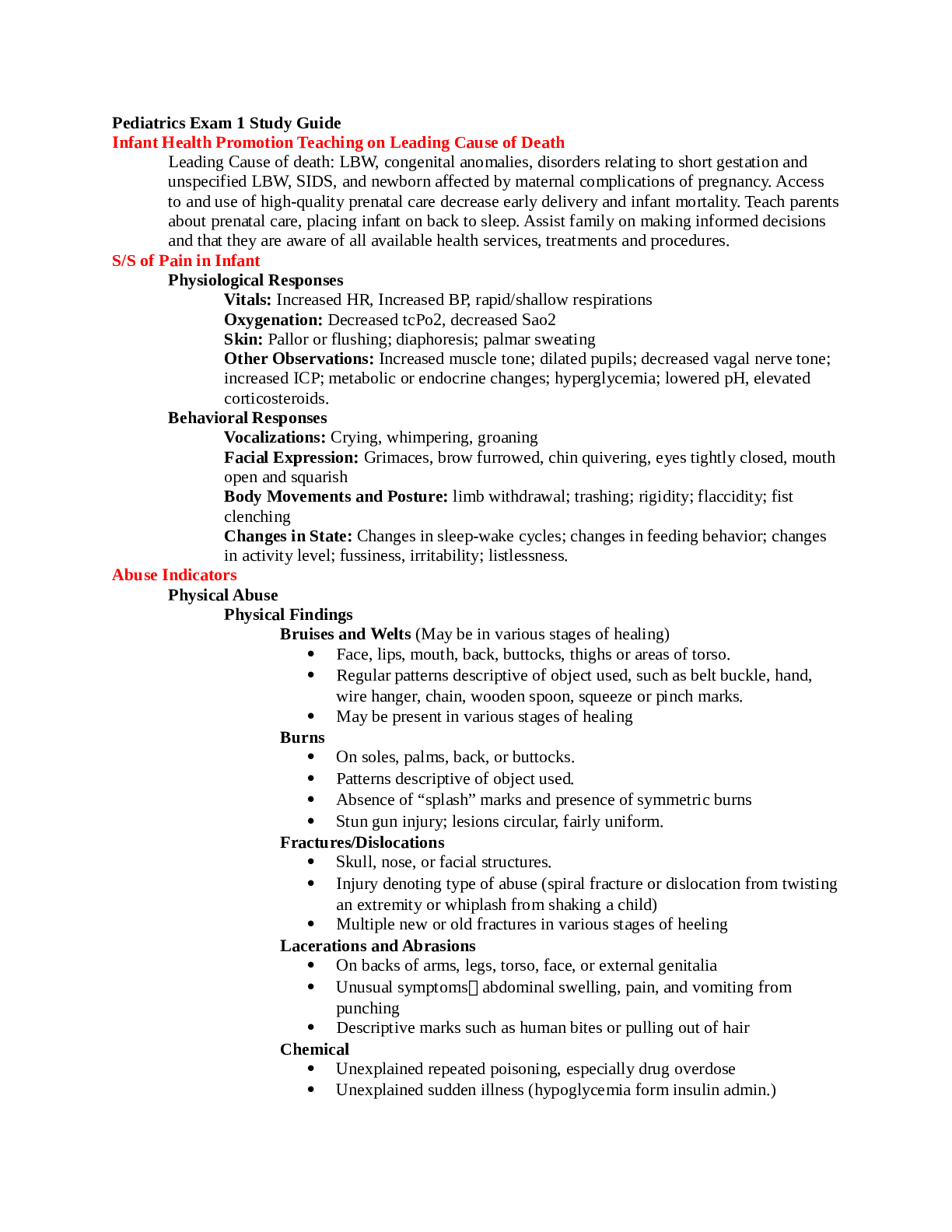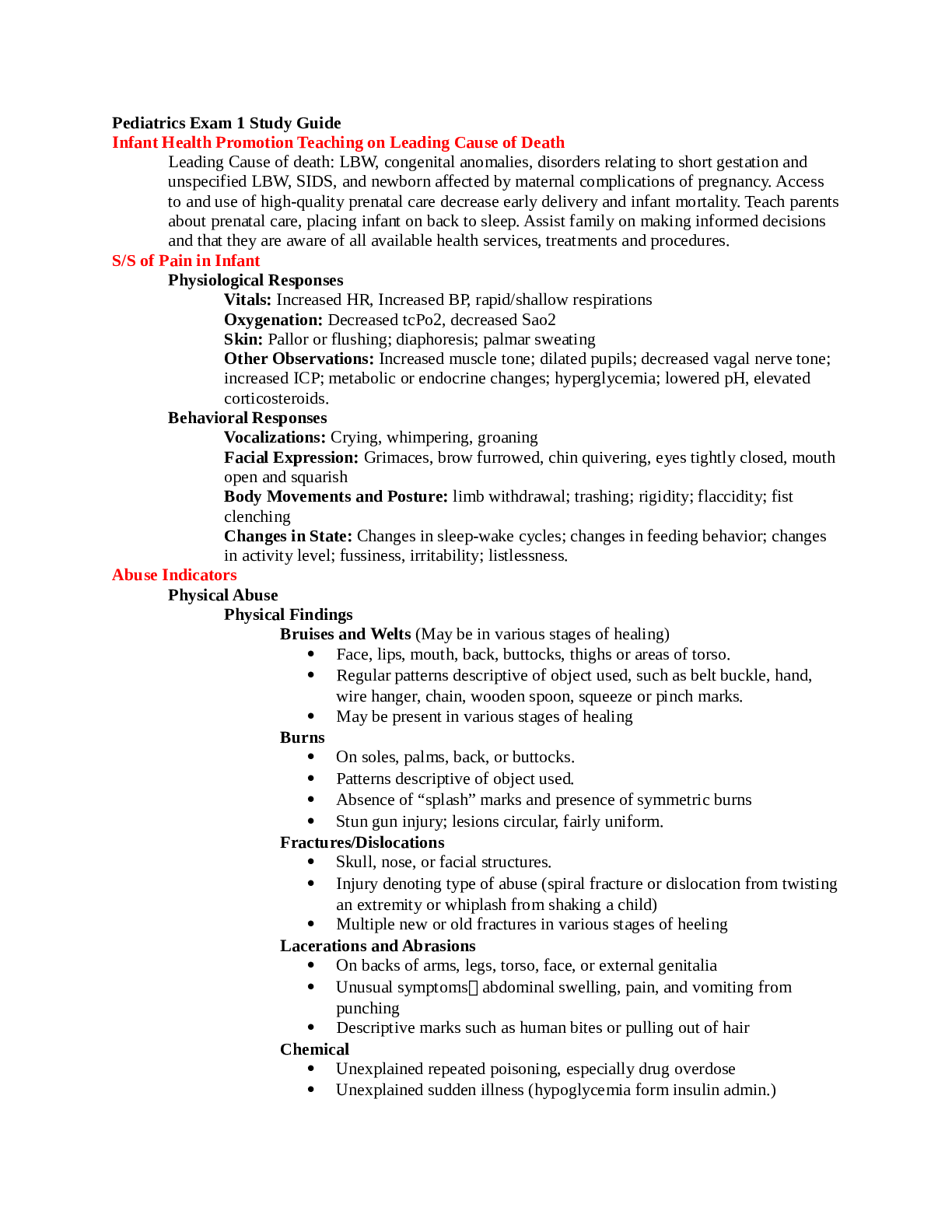Infant Health Promotion Teaching on Leading Cause of Death
Leading Cause of death: LBW, congenital anomalies, disorders relating to short gestation and
unspecified LBW, SIDS, and newborn affected by maternal complications of pregnancy. Access
to and use of high-quality prenatal care decrease early delivery and infant mortality. Teach parents
about prenatal care, placing infant on back to sleep. Assist family on making informed decisions
and that they are aware of all available health services, treatments and procedures.
S/S of Pain in Infant
Physiological Responses
Vitals: Increased HR, Increased BP, rapid/shallow respirations
Oxygenation: Decreased tcPo2, decreased Sao2
Skin: Pallor or flushing; diaphoresis; palmar sweating
Other Observations: Increased muscle tone; dilated pupils; decreased vagal nerve tone;
increased ICP; metabolic or endocrine changes; hyperglycemia; lowered pH, elevated
corticosteroids.
Behavioral Responses
Vocalizations: Crying, whimpering, groaning
Facial Expression: Grimaces, brow furrowed, chin quivering, eyes tightly closed, mouth
open and squarish
Body Movements and Posture: limb withdrawal; trashing; rigidity; flaccidity; fist
clenching
Changes in State: Changes in sleep-wake cycles; changes in feeding behavior; changes
in activity level; fussiness, irritability; listlessness.
Abuse Indicators
Physical Abuse
Physical Findings
Bruises and Welts (May be in various stages of healing)
Face, lips, mouth, back, buttocks, thighs or areas of torso.
Regular patterns descriptive of object used, such as belt buckle, hand,
wire hanger, chain, wooden spoon, squeeze or pinch marks.
May be present in various stages of healing
Burns
On soles, palms, back, or buttocks.
Patterns descriptive of object used.
Absence of “splash” marks and presence of symmetric burns
Stun gun injury; lesions circular, fairly uniform.
Fractures/Dislocations
Skull, nose, or facial structures.
Injury denoting type of abuse (spiral fracture or dislocation from twisting
an extremity or whiplash from shaking a child)
Multiple new or old fractures in various stages of heeling
Lacerations and Abrasions
On backs of arms, legs, torso, face, or external genitalia
Unusual symptoms abdominal swelling, pain, and vomiting from
punching
Descriptive marks such as human bites or pulling out of hair
Chemical
Unexplained repeated poisoning, especially drug overdose
Unexplained sudden illness (hypoglycemia form insulin admin.)
Suggestive Behaviors
Wary of physical contact with adults; apparent feat of parents or going home;
lying very still while surveying environment; inappropriate reaction to injury,
such as failure to cry from pain; lack of reaction to frightening events;
apprehension when hearing other children cry; indiscriminate friendliness and
displays of affection; superficial relationships; acting-out behavior, such as
aggression to seek attention; withdrawal behavior.
Emotional Abuse and Neglect
Physical Findings: Growth failure, eating disorder, enuresis or sleep disorder.
Suggestive Behaviors: Self-stimulatory behaviors; during infancy; lack of social smile
and stranger anxiety. Withdrawal form environment and people; unusual fearfulness.
Antisocial behavior; extremes of behavior; lags in emotional and intellectual
development; suicide attempts.
Sexual Abuse
Physical Findings: Bruises, bleeding, lacerations, or irritation of external genitalia, anus,
mouth or throat. Torn, stained, or bloody underclothing. Pain on urination or pain,
swelling, and itching of genital area. Penile discharge. STD. Difficulty walking or sitting,
unusual odor in the genital area, recurrent UTIs, presence of sperm, or pregnancy in
young teen.
Suggestive Behaviors: Sudden emergence of sexual problems; withdrawn behavior;
preoccupation with fantasies; poor relationships with peers. Sudden changes in weight or
behavior; excessive anger at parents. Regressive behavior; sudden onset of phobias.
Running away from home, substance abuse, personality changes. Rapid declining school
performance; suicide attempts.
Nursing Care: Priority is removing child. Care for child the same way as any other; do not treat
them as a victim. Implement teaching through demonstration.
Infant’s Vital Signs
Read More


